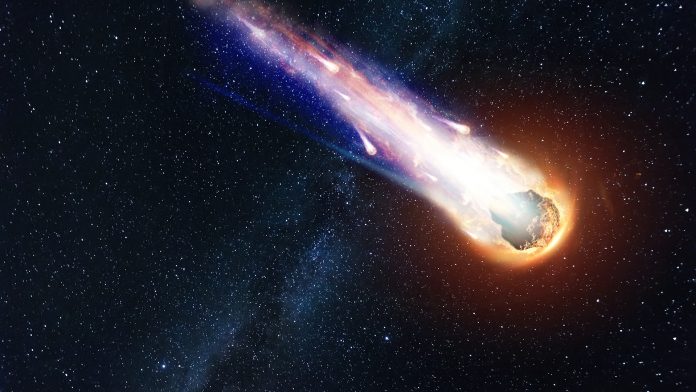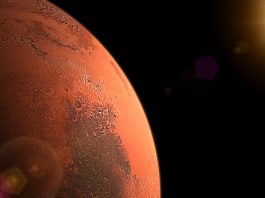NASA’s first ever planetary defence test is launched, that deliberately collides a spacecraft into an asteroid called Dimorphos.
Lawrence Livermore National Laboratory (LLNL) is taking part in NASA’s first-ever planetary defence test, that deliberately collides a spacecraft into an asteroid called Dimorphos. The Double Asteroid Redirect Test (DART) will study technologies that will prevent potential hazardous asteroid’s or comets from impacting Earth.
DART will highlight that a spacecraft can autonomously navigate to a target asteroid and intentionally collide with it; a method of deflection called kinetic impact. DART is the first demonstration of this kinetic impactor technique to alter the motion of an asteroid in space. The asteroid is a small moon of a larger asteroid called Didymos. The impact of Dimorphos does not pose any danger to Earth.
LLNL’s role as participants in the DART mission include a working group focused on modelling the impact and deflection of the asteroid. Megan Bruck Syal, is head of LLNL’s Planetary Defence group. She said she looks forward to the experiment and is excited to assist NASA and the Lab’s mission partners to use this experiment to help advance the science of planetary defence.
Modelling the impact and deflection of the asteroid
“Our team has been supporting DART with impact simulations and analysis since 2015, and it is an incredible feeling to be on the precipice of its launch,” Bruck Syal explained. “DART is an essential first test of kinetic impact deflection effectiveness and will inform how we model asteroid response to a variety of mitigation techniques in the future. Many students, postdocs and staff at LLNL have contributed to our preparedness for this experiment; it is a true interdisciplinary team effort.”
Katie Kumamoto, a LLNL geoscientist and fellow member of the LLNL impact modelling team, said DART is a ground-breaking mission and a big step toward practical asteroid preparedness.
“We don’t have a lot of data on the properties of asteroids, like their strength or density, but these properties can have a large effect on the magnitude of the deflection we would get from a kinetic impact,” added Kumamoto. “DART is thus a two-fold opportunity, to both demonstrate that we can actually deflect an asteroid in space and get us more data on the properties of asteroids, which will help us prepare for potential future impacts.”
Team member Cody Raskin has helped assist in developing simulation tools and methods for the inverse problem of determining the asteroid’s material properties by measuring its response to the impact of the DART spacecraft. As a result, this includes adapting machine learning techniques in order to characterise the mapping software that connects asteroid material properties to the change in momentum imparted by the impact.
“One of the major unanswered questions in the field of planetary defence is just what these near-Earth asteroids are actually made of, and how they might react to kinetic impactors,” Raskin stated.
Spheral models impact, damage, and fragmentation in planetary defence test
LLNL is providing impact modelling expertise to the DART mission using Spheral, a mesh-free code well suited for modelling impact, damage and fragmentation of materials undergoing strong shocks and extreme deformation. The Spheral code achieves this by utilising a variety of mesh-free discretisation’s of solid and fluid dynamics. This includes a variety of important material properties such as strength, elastic-plastic flow, shock physics, damage evolution, and fragmentation.
Developer of the Spheral code, Mike Owen, explained that the mesh-free nature of Spheral allows researchers to naturally follow materials through large deformations and topological changes accurately. This however cones at the cost of increased complexity and higher computational expense compared with ordinary meshed discretisation’s of fluid-flow.
“For this reason, Spheral is also highly parallel, taking advantage of modern supercomputer clusters and allowing us to tackle large three-dimensional problems like the DART impact in reasonable times,” Owen said.
Reflecting on LLNL’s role and contribution
Acting division leader for the Design Physics Division, Paul Miller, initiated working on planetary defence programmes at LLNL in 2011. He successfully proposed an LDRD Exploratory Research project to examine planetary defence. He assembled a team, and over the course of three years led work that established a capability at LLNL to model the deflection and disruption of asteroids both by means of kinetic impactors and nuclear explosives.
“We also began to develop simulation capabilities for impact effects, particularly water impacts and the subsequent waves and coastal flooding that can occur,” Miller added. “We engaged with outside organisations, including NASA HQ, several of the NASA centres, other NNSA labs and university and international partners. At the end of the three-year LDRD project, we received approval from NNSA HQ to continue the work using programmatic funding.”
In 2015, Miller led a related project that was granted an NNSA Award of Excellence (Planetary Defence Team NA-10 Project). In 2016, Miller went on to contribute to the National Near-Earth Object Preparedness Strategy as a member of the Interagency Working Group for Detecting and Mitigating the Impact of Earth-bound Near-Earth Objects (or DAMIEN) of the National Science and Technology Council. Coordinated by NASA and the Office of Science and Technology Policy in the White House, the document lays out the official US approach to address the hazard.
As a result of the capabilities that were recognised, LLNL became involved as participants in the DART mission and the working group focused on modelling the impact and deflection of the asteroid.
“The mission is important because it is the first test of deflection of an asteroid by kinetic deflection and it is expected to provide validation of computer models of the amount of deflection,” Miller explained. “Validation is important because, in the event of a future need to deflect an asteroid, the models will be utilized to assess the adequacy of any planned deflection efforts.”
DART is directed by NASA to the Johns Hopkins Applied Physics Laboratory with support from various NASA centres: the Jet Propulsion Laboratory, Goddard Space Flight Centre, Johnson Space Centre, Glenn Research Centre and Langley Research Centre.









